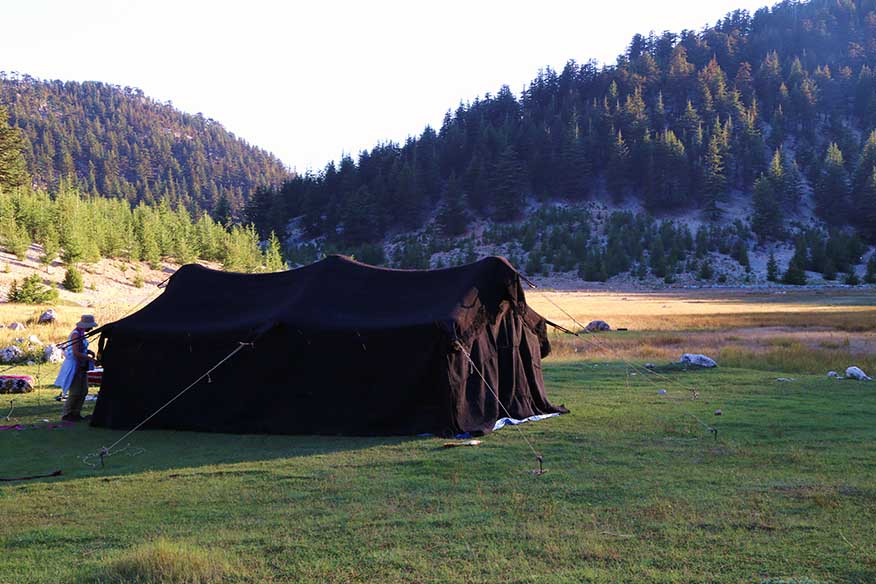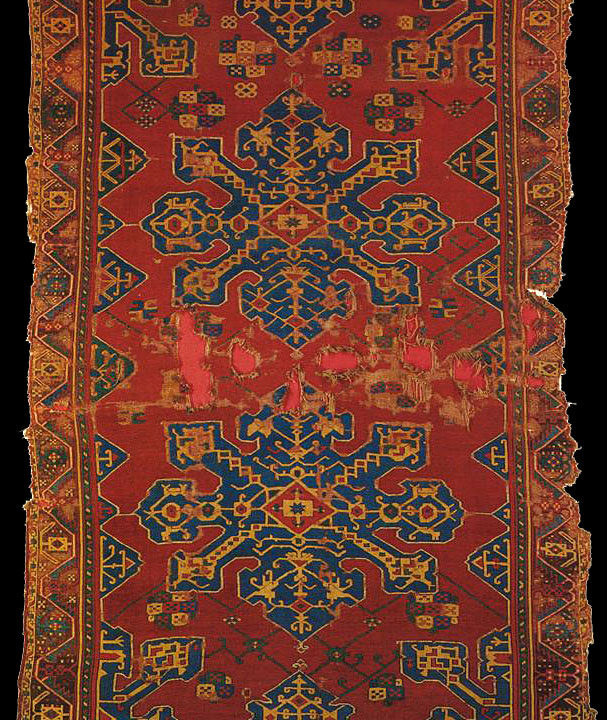
Handwoven Nomadic Bags of Turkey
November 18, 2020
Fiber Culture, The Nomad Way to Use Wool, Goat Hair and Other Fibers in Weavings
November 19, 2020Nomads in Turkey used different types of tribal tents according to their ethnicity, economic factors, and historical events. In recent years, changing life conditions have pushed nomads to leave their traditional tent shapes and materials. In more recent years the shape, the traditional usage methods within the daily life, and the materials used, all determined by the experience of millennia, have not changed, and have transmitted from one generation to the next.

Turkmens of Anatolia depicted in Iskandar-Nameh, the book of Alexander the Great’s life written in 1416

Turkmen tents constructed for the anniversary of the Battle of Manzikert in 1071, the event that provided Turks to settle in Turkey, 2018, Eastern Turkey

An Anatolian Turkmen woman with her traditional costume. Western Turkey

An Anatolian Turkmen lady from Pehlivanlı tribe, Haymana Plateau, Ankara, Central Turkey1909.
In the first stage of tents that Anatolian Turkmens living in Turkey used, the Anatolian version was the round Central Asian type of tent. Its name is Derim Evi (The collection house) or Topak Ev (The round tent). Like the Central Asian version, it was mainly formed from two parts. The lower part is made out of four portable and collapsible walls formed of light willow sticks attached in the form of a diamond-shaped frame. These portable walls are called “derim” meaning, collapsible, or “put together”. The upper part is made from sticks in the form of longbows to be attached to the upper edges of the “derim” and collected and fixed on a wooden circle called the “tünlük”. The bow-shaped sticks are called “uğ”. The wooden parts are fixed to each other with the help of long warp-faced weavings called “tent bands”.

A typical model of Anatolian Turkmen round felt tent very similar to Central Asian tents
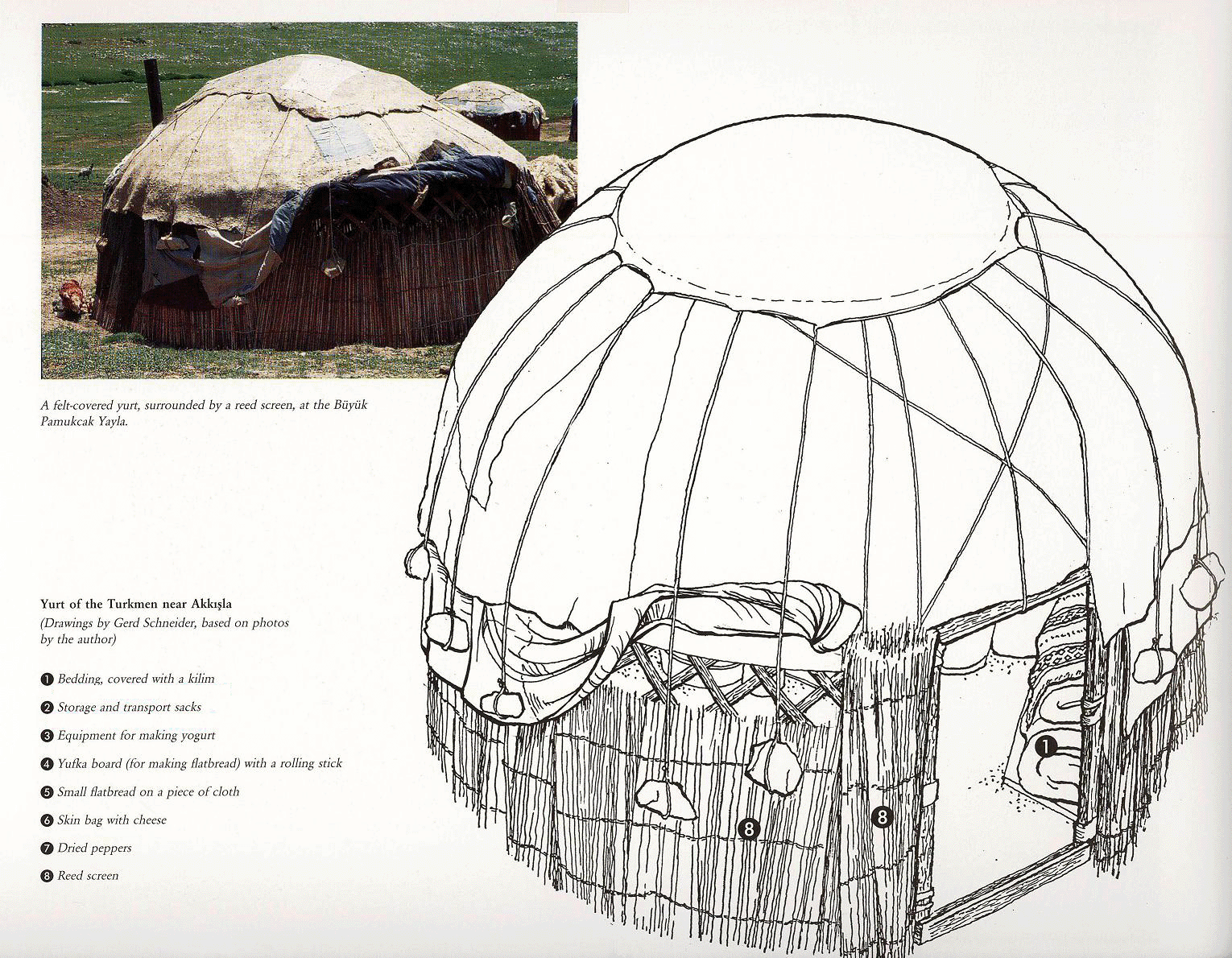
Anatolian Turkmen round felt tent drawing, from the book Nomads in Anatolia by Harald Böhmer

Tünlük, the ceiling of the Anatolian Turkmen tent provides the balance of the tent and the sunlight to come in and the smoke goes out

Tünlük, the ceiling of the Anatolian Turkmen tent provides the balance of the tent and the sunligh to come in and the smoke go out

Turkmen tent frame
This type of tent is covered by felts cut and sewn together in the right form to cover the round tent. The circumference of the tent is generally covered by a long reed screen to keep it stable during powerful winds.

Derim, united to form the wall of the Anatolian Turkmen Tent, Bayat Tribe, Emirdag pasture, Afyon, West-Central Turkey, 1980s

Reed screens going around the tent, “uğ” sticks added to “tünlük” (the ceiling, uniting the walls and the upper part of Anatolian Tukmen tent, Bayat Tribe, Emirdag pasture, Afyon, West-Central Turkey, the 1980s
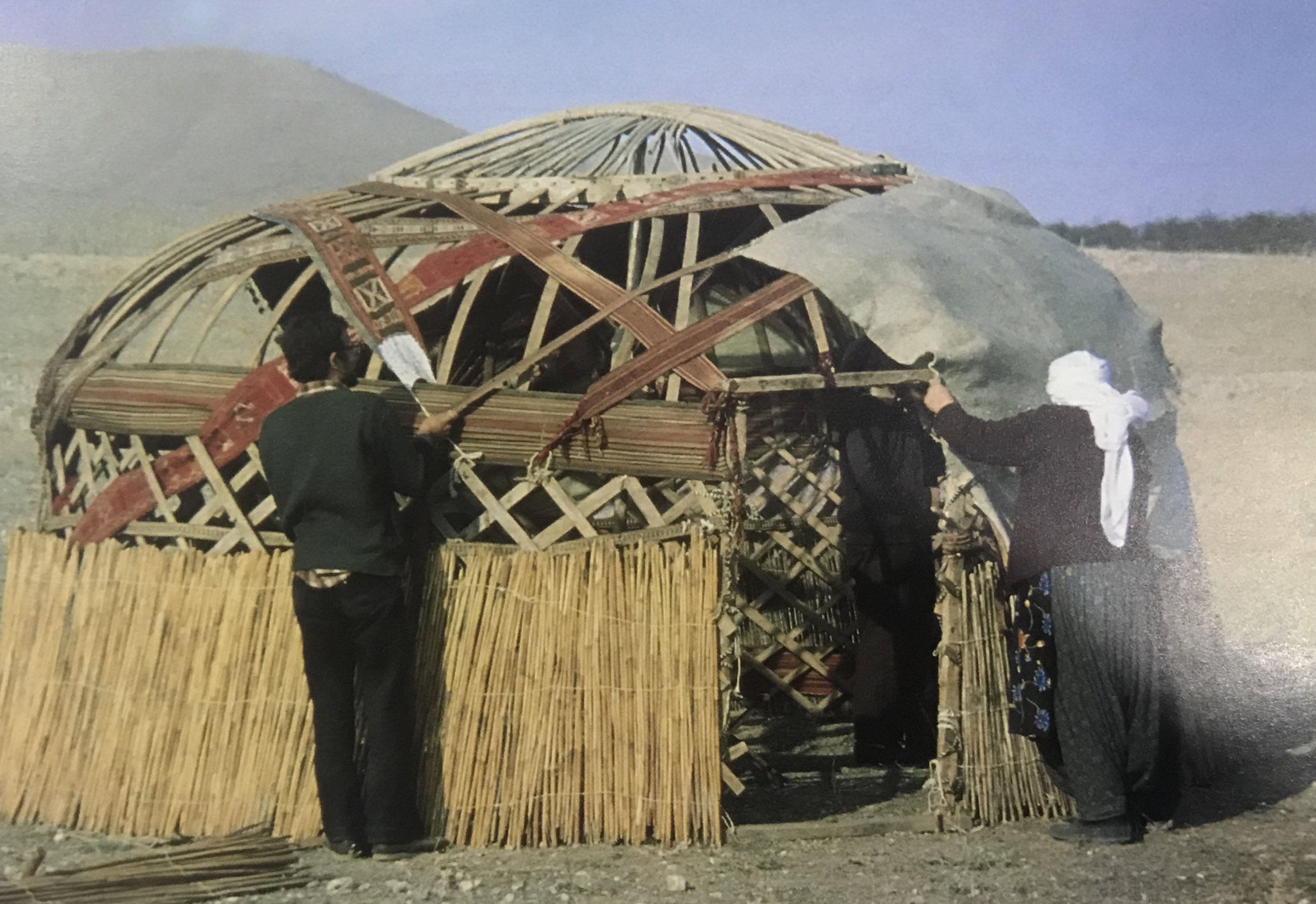
The tent frame fortified and attached with long tent bands, felt coverage of the tent put on the frame Bayat Tribe, Emirdag pasture, Afyon, West-Central Turkey, the 1980s

The felt coverage of the walls is wrapped around the tent, Bayat Turkmens, Emirdağ Pasture, Afyon, West-Central Turkey, 1980s
The usage of this tent was introduced to Anatolia by the immigration of Turks/Turkmens to the Anatolian peninsula in the early 11th century. The tent used for many centuries all around Anatolia, wherever the Turkmens are, is leftover from several successive events in the historical flow of the region. The Ottoman Empire had been having difficulties controlling the movements of nomadic societies as well as collecting taxes and recruiting military forces from them. The economic problems going on in Europe at the end of the 18th and at the beginning of the 19th century, especially a raw material shortage following the industrial revolution, pressured European empires like England to make alliances with the Ottomans to provide cotton and other agriculture products. This event pushed the Ottomans to ban the nomadic activities in some very important plains areas in western and southern Anatolia which were the winter quarters for many nomad tribes. Once the plains were banned from nomadism activities, the sheep more suitable for the plains are changed to the goat, which is more suitable for more mountainous areas, the new lands for Turkmens. So by this development, the round sheep wool-felt is changed by most Anatolian Turkmens to the goat hair rectangular black tent. However, until the late 1970s, some tribes in some limited areas in Anatolia continued to use the round felt tents, such as the Kuzugüdenli-Bayat tribe of Akkışla district of Kayseri city, and the Bekdik Tribe, which is again coming from Bayat Turkmens, in the Ereğli region of Konya, as well as Bayats of the Afyon- Emirdağ region.
.

Afshar tribeswoman in front of Anatolian round felt tent, Tomarza Kayseri Central Turkey 1909, photo courtesy Gertrude Bell

Kuzugüdenli subtribe of Bayat turkmens, using round felt tent, Akkisla, Kayseri, 1980s

Bekdik Turkmens’s felt tent, Niğde, Cental Turkey, the 1980s, photo courtesy Josephine Powell, Suna Kıraç Foundation

Inside the Anatolian round felt tent

The interior of the Anatolian Turkmen tent decorated with handwoven rugs
The second type of nomadic tent which is used in more recent centuries is the black tent. The Anatolian Turkmen black goat hair tent is a square tent erected on a tree, or four central poles and many little side poles. The smallest dimension of the black tent would be 3 meters to 5 meters, the biggest would be 6 meters to 8 meters, which would be the maximum weight that one camel can hold during the migration, which is more or less 250 kg. The four walls of the tent are made up of goat hair fabrics made of 60-70 cm width panels, sewn together side to side to the necessary width. A gabled type of roof, again made of goat hair panels, is erected onto three or four main central poles. The Turkmens kept the long reed screen to wrap over the black goat-hair tent. Both the round felt and rectangle goat hair tents have doors opened either to the south or to the east.
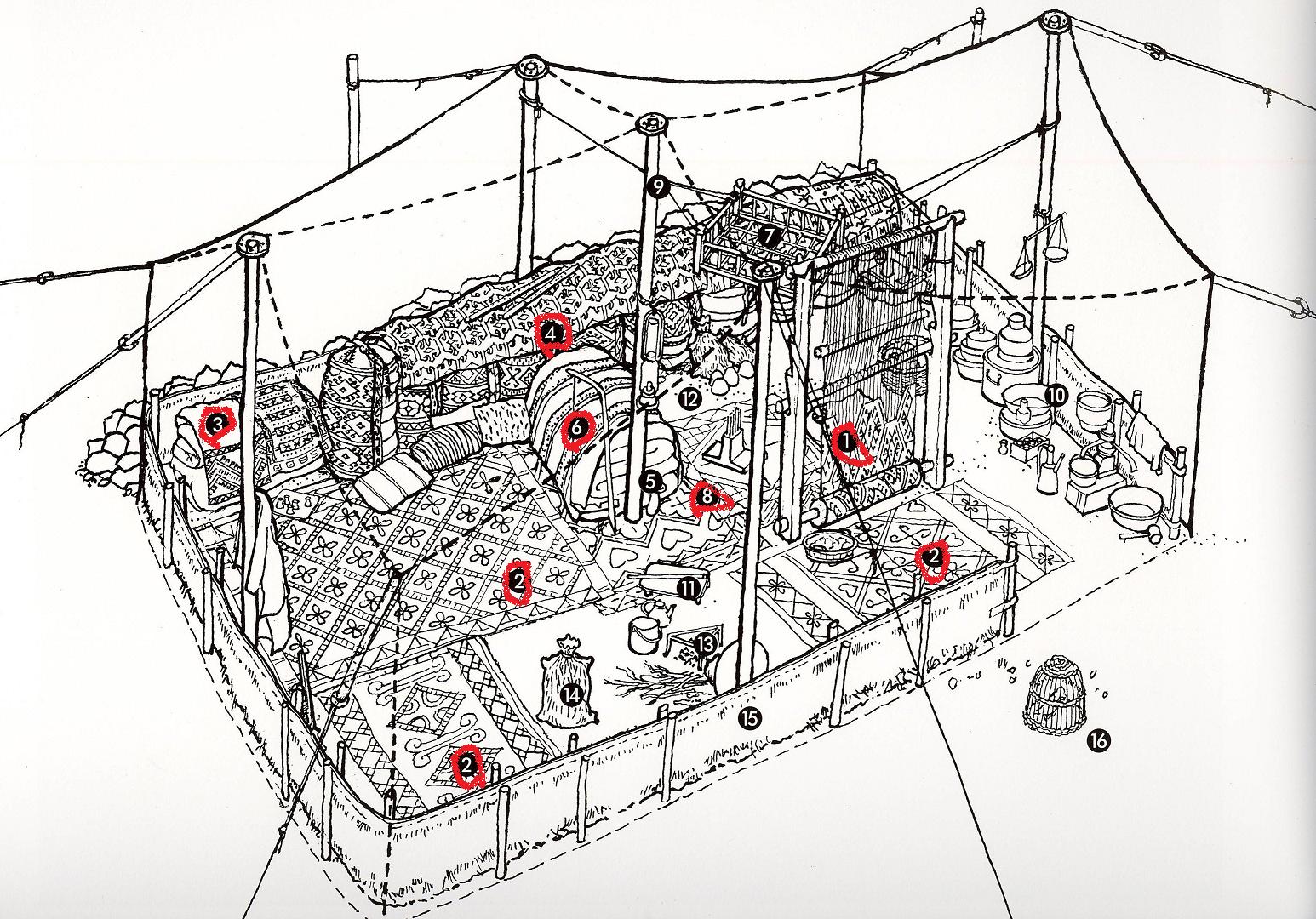
The inside of the Anatolian Turkmen Black Tent

The ceiling of the black tent consist of gabled panels, sewn together, erected on poles. Wiew from the inside, Western Taurus, South Western Turkey, 2018

Goat hair black tent belonging to Sachikara Turkmen tribe. Kahramanmarash, Eastern Turkey, 1980s, Photo by Josephine Powell, Suna Kıraç Foundation

Personal clothing sacks put in the black tent, forming a platform to sit in front. Josephine Powell exhibition, Koç Foundation, 2006

The nomad way to fix the tent wall to the tent ceiling

Anatolian Turkmen Black tent view from the inside
The Kurdish tribes had lived also in eastern Anatolia for several millennia. With very high plateaus reaching 3000 meters, Eastern Anatolia highlands were Kurdish nomads’ summer quarters. These mountainous areas were more suitable for big goat herds so the material is the black goat hair. Kurdish society lives in extended family groups, so the tent dimension is much bigger than Anatolian Turkmen goat hair tents. The tent itself might be erected upon as many as 15 poles placed five on the north-south axis with a tree row along the east-west axis. The Kurdish tent has the kitchen room, which is the women’s part, and the living room, which is the men’s part, and also serves from time to time for some protection for the newly born lambs and goats.

Kurdish Black tent from the back side, Atmalı Tribe, Engizek Mountains, Kahramanmaras Eastern Turkey, 1984, Photo courtesy Josephine Powell, Suna Kıraç Foundation

Engizek Mountains, pasture of Atmali Kurdish Tribe, Kahramanmarash, Eastern Turkey, 1984, photo courtesy Josephine Powell, Suna Kıraç Foundation
The Kurdish tent is also divided by reed screens and also by a specific warp-faced weaving called a “perdeh” (curtain). The circumference of the tent is wrapped again by the reed screens to block the wind.
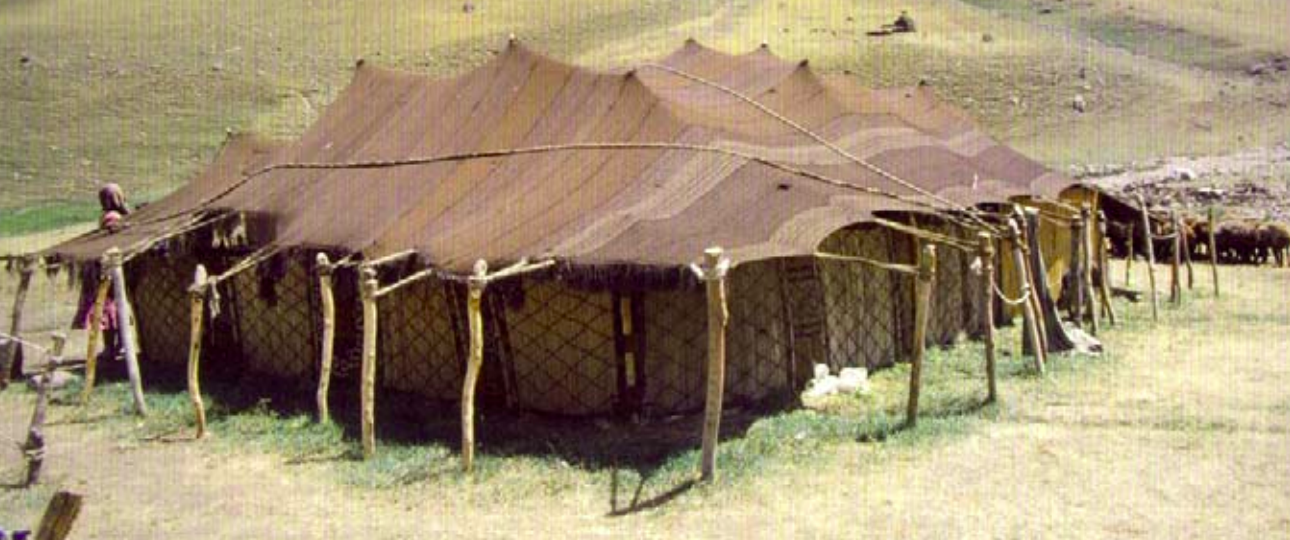
Reed screen going around the Kurdish black tent, Ağrı Mountain, North-Eastern Turkey
All of these traditional tents and the daily life organized around them are the fruits of millennia of experience and wisdom. So one day soon, we wish you to experience this lifestyle with The Black Tent Project.

